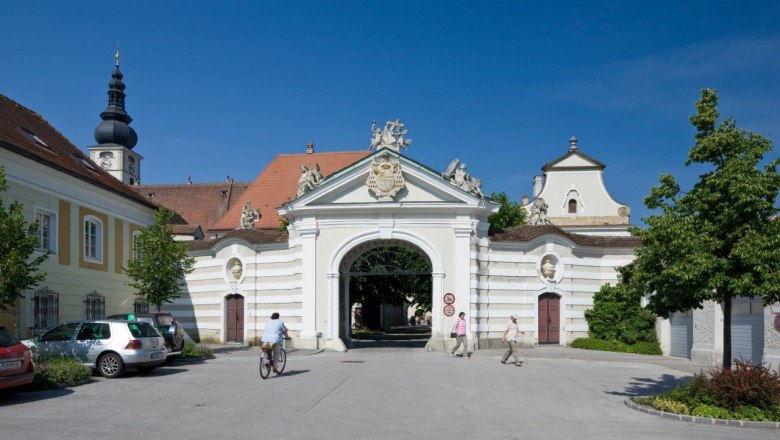Bistumgsgebäude
Description
From baroque monastery complex to spiritual center.
To the north of the cathedral, today's diocese building is a historically and artistically significant building complex: the former Augustinian canons' monastery, which is still the spiritual center of the diocese of St. Pölten today. The complex, consisting of five courtyards, is exemplary of the Baroque monastery buildings of the 17th and 18th centuries - and is also a treasure house of sacred art.
A new baroque monastery building with a medieval heritage
The current monastery complex dates back almost entirely to a new building under Provost Johannes Fünfleuthner, which was completed around the middle of the 17th century. A door in the north aisle of the cathedral leads to the cloister, which was built at the same time and whose east side is adorned with several late medieval tombstones. The tomb of the Hagenauer family with a crucifixion relief from 1337 is outstanding - the most important medieval work of art in the abbey area.
Baroque art chamber: library, oratory, diocesan museum
A staircase in the north-east corner of the cloister leads to the Diocesan Museum, which was reopened in 1988. It includes the baroque abbey library, which is one of the highlights of baroque sacred art in St. Pölten with sculptures by Peter Widerin and frescoes by Daniel Gran and Paul Troger.
The south wing houses the episcopal oratory, which is directly adjacent to the cathedral - a place of spiritual contemplation and cultural exchange.
Fountain courtyard, baroque grilles and a prominent guest
A gate on the north side of the cloister leads to the fountain courtyard, named after the elegant marble fountain from the second half of the 17th century. The east wing houses the impressive main staircase, once the representative entrance to the canons' guest wing. The baroque lattice gate from 1727 marks the entrance, above which there is a plaque commemorating Franz Schubert's visit to Bishop Dankesreither - a reminder of the composer's short but memorable stay in St. Pölten.
Inside, a richly stuccoed staircase leads upwards, flanked by figures of St. John of Nepomuk and St. John Cantius, complemented by a wall relief "Raphael with Tobias" by Jakob Christoph Schletterer.
Abbey gate with allegory and remembrance
The Bischofsallee finally leads into the Bishop's Gate, which forms the eastern end of the former abbey area. This latest known work by Joseph Munggenast bears the allegorical figures "Faith, Hope, Love" as well as the coat of arms of Bishop Kerens, which was added later. Originally located around 15 meters further east, the gate was moved to its current location in 1908 as part of the construction of the district administration building.
Shortly before this, a special architectural testimony can be discovered on the right behind the monastery wall: part of the preserved Romanesque apse of the cathedral - a silent greeting from the Middle Ages in the midst of Baroque splendor.

